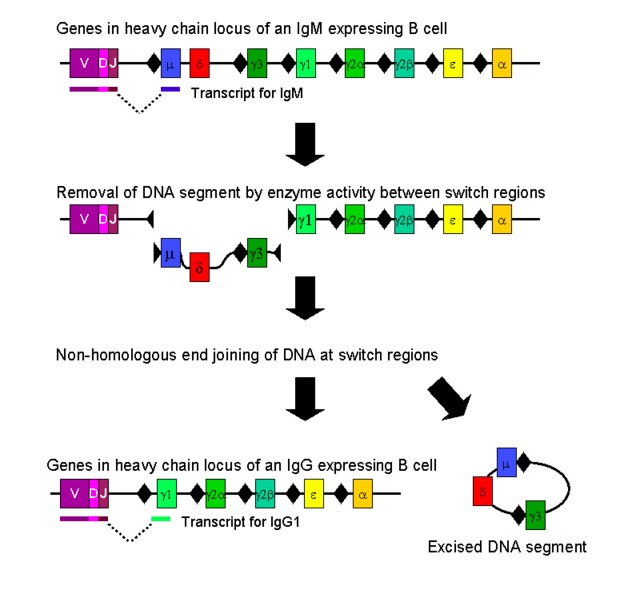Playlist
Show Playlist
Hide Playlist
Major Histocompatibility Complex (MHC) – Antigen Processing and Presentation
-
Slides Processing & Presentation of Antigen.pdf
-
Reference List Immune System.pdf
-
Download Lecture Overview
00:01 The MHC is the major histocompatibility complex. 00:08 It’s called that because it’s a complex of genes, it’s not a single gene. 00:13 And it’s a complex of genes that are the major determinants of tissue compatibility during transplantation. 00:21 That’s how it was first discovered. 00:23 When people were exploring, doing skin grafts for example in mice, between different strains of mice, they recognized that the skin graft from a different strain of mouse would be rejected, immunologically rejected due to recognition of these MHC molecules. 00:40 Well of course, MHC did not evolve to frustrate attempts at transplantation. 00:46 It’s a consequence of the diversity of the MHC but it’s not why we have an MHC. 00:51 We have MHC to show protein antigens in the form of peptides to T-cells. 00:58 In each individual species, the MHC is given a particular name. 01:02 You only need to really know about two of them. 01:05 In the human, it’s called HLA. 01:08 And in the mouse, it’s called H-2. 01:11 It’s worth knowing that because a lot of immunology is worked out in the mouse. 01:15 So when you’re reading textbooks and so forth, you may often come across H-2. 01:19 It’s simply the MHC of the mouse, just like HLA is the MHC of the human. 01:28 There are two classes of MHC - MHC Class I and MHC Class II. 01:36 And they are very similar in structure and very similar in what they do as we’ll learn very shortly. 01:43 There are three types of MHC Class I in the human: HLA-A, HLA-B and HLA-C. 01:52 And for Class II we have HLA-DP, HLA-DQ and HLA-DR. 02:00 The MHC Class I molecules are present on all nucleated cells in the body. 02:05 That’s essentially all cells in the body apart from red blood cells. 02:11 However, the MHC Class II is only present on a very limited number of cell types. 02:17 Essentially professional antigen presenting cells, which are the dendritic cells, the macrophages and the B-cells, and on thymic epithelium. 02:27 And in fact, these professional antigen presenting cells are defined as such by having MHC Class II on their surface. Now I’ve already mentioned that Class I is present on all nucleated cells in the body. And of course dendritic cells, macrophages, B-cells, thymic epithelium, they’re nucleated cells as well. So these cells have both MHC Class I and MHC Class II. 02:50 So it’s not an alternative, it’s an addition to the Class I. 02:54 The function of MHC Class I is to alert CD8+ cytotoxic T-cells to the presence of intracellular antigens; for example, a virus infecting a cell. 03:10 Whereas MHC Class II is specialized to alert CD4+ helper T-cells and CD4+ regulatory T-cells to the presence of extracellular antigens such as bacteria. 03:24 Let’s explore the MHC gene locus. 03:28 We’ve already heard that there are two classes of MHC - MHC Class I and Class II. 03:34 In the humans, these genes are present on chromosome 6. 03:40 HLA Class I consists of HLA-A, -B and -C as we’ve heard. 03:47 And they’re actually arranged in this order. 03:49 You may think that there’s misordering here, looks a bit odd doesn’t it, it’s not ABC, it’s BCA. 03:56 And that’s simply the order that these genes are present on the chromosome. 04:01 And the Class II genes for DQ, DQ, DR. 04:07 In fact there’s another region within the MHC that’s called MHC Class III. 04:12 These genes do not actually encode antigen presenting molecules. 04:16 So they’re really nothing much to do with what we’re talking about at the moment. 04:20 But actually they do encode molecules that are part of the immune response. 04:25 So complement component C4, complement component Factor B that’s part of the alternative pathway of complement activation, complement component C2, lymphotoxin which is a cytokine and another cytokine, TNF-α, are all encoded within the MHC Class III region. But we’re going to focus our attention now on the MHC Class I and Class II antigen presenting molecules.
About the Lecture
The lecture Major Histocompatibility Complex (MHC) – Antigen Processing and Presentation by Peter Delves, PhD is from the course Adaptive Immune System. It contains the following chapters:
- The Major Histocompatibility Complex
- The MHC Gene Locus
Included Quiz Questions
What is an example of an MHC class II molecule?
- HLA-DR
- HLA-A
- HLA-B
- HLA-C
- Factor B
Which of the following comparisons between MHC Class I and MHC Class II is CORRECT?
- MHC I: Present on all nucleated cells in the body MHC II: Present on antigen-presenting cells
- MHC I: Alerts CD4+ T cells MHC II: Alerts CD8+ T cells
- MHC I: Present on red blood cells MHC II: Present on antigen-presenting cells
- MHC I: Binds peptides derived from extracellular antigens MHC II: Binds peptides derived from intracellular antigens
- MHC I: Alerts helper T cells MHC II: Alerts cytotoxic T cells
Major histocompatibility complex (MHC) class III gene encodes for all EXCEPT which of the following?
- Complement component 3
- Factor B
- Lymphotoxin
- Complement component 4
- Tumour necrosis factors-alpha
Customer reviews
3,0 of 5 stars
| 5 Stars |
|
0 |
| 4 Stars |
|
0 |
| 3 Stars |
|
1 |
| 2 Stars |
|
0 |
| 1 Star |
|
0 |
While the lecture itself is very informative the fact that MHC is referred to many times before this point means that it needs to be much earlier in the playlist.





